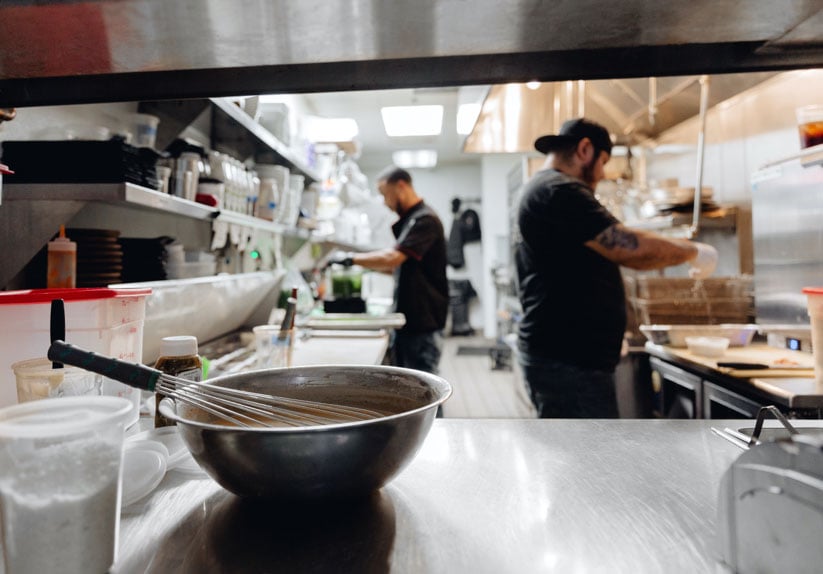 Tavern at Ivy City Smokehouse, Washington D.C.
Tavern at Ivy City Smokehouse, Washington D.C.
The Tavern at Ivy City Smokehouse boosts their bottom-line and gains cost insights

The Tavern at Ivy City Smokehouse
- Location: Washington, DC
- # of Restaurants: 5
- Restaurant Type: American casual
- Tech Stack: Simphony POS & Real World Accounting
- Key Features: Daily P&L, Invoice Processing, Order guides
The goal
Greg Casten had a mountain of invoices to deal with while growing his restaurant portfolio (so big he had to store them in a tractor-trailer). Just coding the invoice data averaged 30 to 40 hours per week.
[me] solution
MarginEdge significantly improved Greg’s financial record-keeping and organization by empowering him with access to invoices, vendors, products, deliveries, and pricing information from anywhere. The software also improved efficiency and accuracy in recipe calculations and inventory management and helped detect theft and waste. Now Greg can make data-driven decisions on the fly when it counts.
“ I especially like the interim P&L because you can look at things like category spend per month at any time, even mid-month, so you can make on-the-fly adjustments to your purchasing, pricing, or plating. ”
Greg Casten | Owner
Greg Casten is a Washington, D.C. industry icon. For over three decades, he has been a power player as a partner in some of the District’s most well-known and busiest restaurants – Tony & Joe’s Seafood Place, Nick’s Riverside Grill, and, most recently, The Tavern at Ivy City Smokehouse – as well as ProFish Limited, the city’s premiere seafood supplier. Casten’s deep relationship with the hospitality world also included a long stint serving as President of the Restaurant Association of Metro Washington, and roles with other hospitality-minded boards, such as Destination DC and Educated Eats. Casten has a degree in accounting from Bentley University, so he knows numbers and how to work a P&L statement. When he went looking for software to manage his purchase and sales data, he researched carefully to find the solution that best addressed the back-office and purchasing challenges he had experienced.
Before MarginEdge: paper, paper everywhere
For most of his career, Casten was a hard-copy guy. As the number of units in his portfolio grew, so did the mountain of paperwork. He kept every invoice on file, accumulating so many he ultimately rented a tractor-trailer truck to store them all. With three restaurants eclipsing $20M in annual sales, every week he and his staff spent 30-40 hours coding and inputting invoices. It was a time-consuming, cumbersome process that produced a ponderous paper trail that was hard to manage and access quickly.
Less paper, more control
Three years ago, Casten began using MarginEdge, implementing it first at Tony & Joe’s at Washington Harbor. (As an early user of the system, Casten was so blown away by the impact it could have on the industry, he became an early stage investor.) He was initially attracted to MarginEdge for its ability to consistently and correctly maintain records. “Just having the ability to go to the source invoice and investigate what was going on gave me a bigger, better sense of control,” he says. “As I was opening other units in different locations, it was getting harder and harder for me to put my hands on the invoices I needed when I needed them.”
MarginEdge gave Casten a newfound degree of independence. No longer did he need to call on staff to retrieve an invoice – he could do that on his own, anywhere, at any time. And he could review invoices in a multitude of ways, giving him a wealth of information about vendors, products, deliveries, and pricing.
“I especially like the interim P&L because you can look at things like category spend per month at any time, even mid-month, so you can make on-the-fly adjustments to your purchasing, pricing, or plating.”
Streamlining & saving time
The software also made it easier to set up new vendors and manage their order guides, since new items are created automatically as invoices come. The system also handles the assigning of new items to master products, which can be used on inventory and in recipes. “Those steps are usually very hard to maintain,” says Casten, “so when trying to do it by hand, it’s nearly impossible to get the most updated material cost when you’re doing your recipe calculations.”
MarginEdge has been a BIG win for the overall financial record keeping system and organization. It has reduced the man hours spent on this work by Casten and his team from hours per week down to minutes per week, plus the amount of paperwork in general has been massively reduced. As his time with MarginEdge progressed, he was able to throw away old paperwork – and ultimately get rid of the tractor-trailer truck that served as his records warehouse. And perhaps best of all, on top of improving efficiency dramatically, MarginEdge consistently delivers a vastly improved level of data quality than before.
Getting even more from the system
As he grew more comfortable with the software and desired to do more with it, Casten began to take advantage of MarginEdge’s other tools and functions. By the time he opened the The Tavern at Ivy City Smokehouse, he was able to leverage all of the features of the system. “I use everything,” he says. “From the recipes, to inventory, to analyzing theoretical usage versus actual, to the interim P&L statement. I especially like the interim P&L because you can look at things like category spend per month at any time, even mid-month, so you can make on-the-fly adjustments to your purchasing, pricing, or plating.”
Positive changes
Casten reviews each menu item and its price using MarginEdge to determine where savings can be made. Sometimes he will tick-up the price of an item. Other times, he will ratchet down his costs by changing the composition of the dish, reducing a portion size, substituting an ingredient, or even removing an item. For example, he has removed fries from some plates, after the system helped Casten realize just how large a monthly line-item expense fryer oil was.
Using MarginEdge, Casten is not only able to track food and beverage data, but he is also able to track the history of each piece of equipment to see if it has a higher rate of maintenance than is normal. “That helps me figure out abuse,” he says. “MarginEdge helps me focus on why a particular A/C unit has had a repairman come out three times in a month. I can quickly review all of the repairman’s invoices to see what work was done and why.”
The software also helps catch theft and unnecessary waste. For example, Casten discovered a large amount of high-end tequila was missing from inventory. He confronted his bartenders and discovered they were giving it away to favored guests. So, he instituted a policy that still allowed bartenders to pour guests a thank you shot but using rail liquor instead.
“Just the first year I used MarginEdge, I saved about 2% of gross. That’s big money, which makes me a big fan of MarginEdge.”
Superior Savings
In addition to reducing paperwork and storage costs, and streamlining operations overall, all of the changes Casten instituted have added up to big savings. “Just the first year I used MarginEdge, I saved about 2% of gross,” he says. “That’s big money, which makes me a big fan of MarginEdge.”



